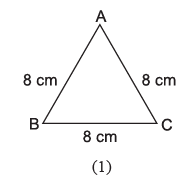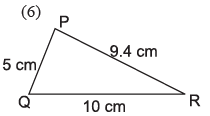Understanding Elementary Shapes Class 6 Worksheet Maths Chapter 5
MCQs
Q1: Which type of triangle has two sides of equal length?
(a) Equilateral triangle
(b) Isosceles triangle
(c) Scalene triangle
(d) Right-angled triangle
Ans: (b) Isosceles triangle
An isosceles triangle has exactly two sides of equal length. The third side can be of a different length.
Q2: How many bases does a trapezium have?
(a) 1
(b) 2
(c) 3
(d) 4
Ans: (b) 2
A trapezium (or trapezoid) has two parallel bases and two non-parallel sides.

Q3: What is the measure of each angle in an equilateral triangle?
(a) 60°
(b) 90°
(c) 120°
(d) 180°
Ans: (a) 60°
In an equilateral triangle, all three angles are equal and add up to 180°. Therefore, each angle measures 60°.

Q4: What type of angle is exactly 180°?
(a) Acute angle
(b) Right angle
(c) Straight angle
(d) Reflex angle
Ans: (c) Straight angle
A straight angle measures exactly 180°, forming a straight line.

Q5: Which type of triangle has all sides of different lengths?
(a) Equilateral triangle
(b) Isosceles triangle
(c) Scalene triangle
(d) Right-angled triangle
Ans: (c) Scalene triangle
A scalene triangle has all sides of different lengths, and all angles are also different.
Types of Triangles
Q6: Identify the following triangles according to the measurement of sides and angles given. Also mention the type of triangle:






Ans: (1) ∆ABC: Equilateral and acute angled triangle
(2) ∆DEF: Isosceles triangle and acute angled triangle
(3) ∆GIH: Scalene triangle and right angled triangle
(4) ∆JKL: Isosceles triangle and obtuse angled triangle
(5) ∆MNO: Scalene triangle and obtuse angled triangle
(6) ∆PQR: Scalene triangle and acute angled triangle
(7) ∆STV: Isosceles triangle and right angled triangle
Fill in the Blanks
Q7: Each angle of a rectangle is a ____________ angle.
Q8: ____________ sides of a rhombus are of equal length.
Q9: In a ____________, there is only one pair of parallel sides.
Q10: The ____________ sides of a rectangle are equal in length.
Q11: A rhombus with four right angles is called a ____________.
Q12: The polygon with least number of sides is ____________.
Ans 7:Right angle
Ans 8: All
Ans 9: Trapezium
Ans 10: Opposite
Ans 11: Square
Ans 12: Triangle
 |
Download the notes
Worksheet Solutions: Understanding Elementary Shapes
|
Download as PDF |
Answer the following Questions
Q13: Complete the following table:
(One is done as example-sphere)
Shape | Example | Number of faces | Number of vertices | Number of Edges | |
(1) | Cuboid | — | — | — | — |
(2) | Cube | — | — | — | — |
(3) | Triangular pyramid | — | — | — | — |
(4) | Sphere | Football | No face | No vertex | No edge |
Ans:
Shape | Example | No. of Faces | No. of vertices | No. of edges |
Cuboid | Math book | 6 | 8 | 12 |
Cube | Die | 6 | 8 | 12 |
Triangular Pyramid | Egypt Pyramid | 4 | 4 | 6 |
Q14: In the given figure, name the following angles as acute, obtuse, right, straight or reflex.
(a) ∠QOY
(b) ∠YOP
(c) ∠ROX
(d) ∠QOX
(e) ∠POQ

Ans:
(a) ∠QOY = acute angle.
(b) ∠YOP = obtuse angle.
(c) ∠ROX = right angle.
(d) ∠QOX = reflex angle.
(e) ∠POQ = straight angle.
Q15: Match the column B with A and C:
| A | B | C |
| (a) Straight angle | (i) An angle whose measure is less than 90°. | (f) One fourth of a revolution. |
| (b) Right angle | (ii) An angle whose measure is between 90° and 180°. | (g) Half of a revolution. |
| (c) Acute angle | (iii) An angle whose measure is 180°. | (h) More than half a revolution |
| (d) Obtuse angle | (iv) An angle whose measure is 90°. | (i) Less than one-fourth of a revolution. |
| (e) Reflex angle | (v) An angle whose measure is between 180° and 360°. | (j) Between ¼ and ½ of a revolution. |
For example (a) → (iii) → (g)
Ans: (a) → (iii) → (g)
(b) → (iv) → (f)
(c) → (i) → (i)
(d) → (ii) → (j)
(e) → (v) → (h)
Q16: A sailor is rowing a boat due north. In which direction will he be rowing if he turns it through (i) a straight angle (ii) a complete angle
Ans: (i) South
(ii) North
Q17: You are standing in a class-room facing north. In what direction will you be facing after making a quarter turn in clockwise direction?
Ans: East
Q18: Write five capital letters of the English alphabet which show perpendicular lines/line segments.
Ans: E, F, H, I, J, L, T (any five)
Q19: Number of right angles turned by the hour hand of a clock when it goes from 3 to 6.
Ans: When the hour hand of a clock goes from 3 to 6, it turns through one right angle.
Q20: How many line segments are used in making a triangle?
Ans: Three line segments are used to make a triangle.
|
92 videos|353 docs|54 tests
|
FAQs on Understanding Elementary Shapes Class 6 Worksheet Maths Chapter 5
| 1. What are the different types of elementary shapes? |  |
| 2. How can elementary shapes be classified based on their properties? |  |
| 3. How are elementary shapes used in real-life applications? |  |
| 4. Can elementary shapes be combined to create more complex shapes? |  |
| 5. What is the importance of understanding elementary shapes in mathematics? |  |






















